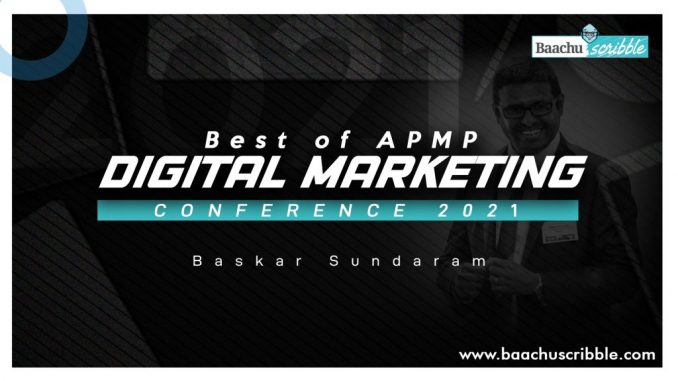
In this session, Baskar Sundaram talks about how you can start your podcast journey.
The power of podcast carries the unique ability of getting into someone’s mind. Why or why not a podcast? It is not a place to sell or to pitch for one’s products and services. It is a key place for one to influence and build trust in the community.
Who is it for? Anyone who will help to build trust and authority in the market. It is important to come together to position oneself as an expert. The market is desperate for thought leadership.
The Goal – even before you even launch a podcast:
Consider the five key episodes. Do not start with one, but five key podcasts. Then, focus on the great parts: content, communication and production.
Why is one doing this? To position oneself as an expert in the market. It is important to join the conversation and join the journey if there are guests in the podcast. It is also about people involved in it.
Have character, charisma, be comfortable with being oneself when launching a podcast. Have chemistry with co-host and guests. Cheer on the listener. Put guest talent at ease and draw out great content. Have a voice that is pleasing to listen t to understand why people are listening and respect the listener’s time.
It includes where it is launched, how it is edited, how music is added to it. It’s about mixing, adding spice to the podcast. Understand that audio branding shapes the content. Edit out repetition, bunny trails etc and clean up audio quality. Mixes and masters audio should not strain the listeners’ ears.
Part 1: Getting Started
Start with an idea. How to find one’s idea? Find a topic that one is passionate and expert in. When the creator has an idea then niche down so one can scale up. There are lots of podcasts, but the niche where it is positioned helps to give it an actual position.
Start with a plan
Step 1: Define the business goals
Where does the podcast fit into the business and sales funnel? Find new influencers and experts in the community and the wider market. It helps to create further content like blogs and social media posts. Create new advertising opportunities that help to increase brand awareness in the market.
Step 2: Define the Mission Statement
State the cadence, purpose, topic scope and how to do it. One can make a mission statement once these four are figured out. Ask oneself if it can be done alone. Having someone to help it with, like a co-host can give additional help. It’s a product of its own and not something for fun. It takes a lot of effort.
Step 3 – Format
Decide on the format like audio or video. Keep it consistent, do not try to mix and match. Traditional podcasts are where the host is the speaker, then there are topic-based, interviews, case studies, inspirational, storytelling and rant. Keep the audience as the key focus. The right kind of podcast depends on the sector one is working in.
Step 4 – Determine the workflow
There is pre and post work for podcast creation. Focus on the first five episodes. Brainstorm what the content for these five will be. Name the podcast.
The artwork – keep it consistent. 1. Keep it simple 2. Dimensions 1400×1400 pixels 3. Format: jpg or png.
Part 2: Equipment and Technology
Do not be constrained by technology. What one needs:
Condenser mic is easy to use when there are no guests. Dynamic mic, a radio type. A Lavalier Mic, perfect for face to face interviews, Shotgun Mic, focused recording and clear sound. The perfect mic depends on the scenario it is used in.
What kind of environment is it being used decides the perfect mic. There are advantages as well. Everyone can be remote. Just need a computer, USB Mic and headphones. It’s very flexible and do-able for busy lives.
Part 3: Recording and Creating the Content
Structure the questions a d have an open vibe environment.
The checklist:
The entertainment checklist –
Part 4 – Post-Production and Hosting
Editing, exporting and hosting the content happens here.
8 Step Editing Process:
1. Sync the audio tracks
Tools one can use are Logic Pro, Adobe Audition, Audacity and Gargeband. Music is also important. One can make custom music or use from stock music.
Use Music to shape the episode. This is the tricky bit. Make sure the music serves the story and content and does not compete for the ear. Some music and genres naturally do better at this than others. Pay attention to the feeling the music evokes and make sure it is what one wants the audience to feel.
Music is not a core content but a fill-up. But there are some Do’s and Don’ts
Do’s with Music:
Don’ts with Music:
Use Music to shape the episode. It adds energy & creates the mood. Provide transitions & segues. Provide a moment to let a powerful thought sink in. Provide a ‘brain break’ after a section of very technical information. Cover bad audio that otherwise can’t be fixed.
The important factor is to know who’s listening, when are they listening and who’s missing. One needs the statistics so choose the platform wisely. Two major podcast platforms are Buzzsprout and Bluberry. This is the ultimate guide to starting your own podcast.

Leave a Reply